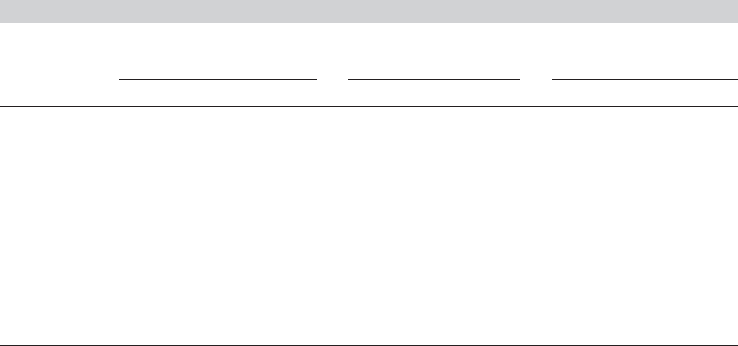Greene W.H. Econometric Analysis
Подождите немного. Документ загружается.


CHAPTER 14
✦
Maximum Likelihood Estimation
589
is a mixture of a finite number of underlying distributions. The model can be motivated
in several ways:
•
In the classic application of the technique, the observed data are drawn from a mix
of distinct underlying populations. Consider, for example, a historical or fossilized
record of the intersection (or collision) of two populations. The anthropological
record consists of measurements on some variable that would differ imperfectly,
but substantively, between the populations. However, the analyst has no definitive
marker for which subpopulation an observation is drawn from. Given a sample of
observations, they are interested in two statistical problems: (1) estimate the
parameters of the underlying populations and (2) classify the observations in hand
as having originated in which population. The technique has seen a number of
recent applications in health econometrics. For example, in a study of obesity,
Greene, Harris, Hollingsworth, and Maitra (2008) speculated that their ordered
choice model (see Chapter 19) might systematically vary in a sample that
contained (it was believed) some individuals who have a genetic predisposition
toward obesity and most that did not. In another contemporary application,
Lambert (1992) studied the number of defective outcomes in a production
process. When a “zero defectives” condition is observed, it could indicate either
regime 1, “the process is under control,” or regime 2, “the process is not under
control but just happens to produce a zero observation.”
•
In a narrower sense, one might view parameter heterogeneity in a population as a
form of discrete mixing. We have modeled parameter heterogeneity using
continuous distributions in Section 11.11. The “finite mixture” approach takes the
distribution of parameters across individuals to be discrete. (Of course, this is
another way to interpret the first point.)
•
The finite mixing approach is a means by which a distribution (model) can be
constructed from a mixture of underlying distributions. Goldfeld and Quandt’s
mixture of normals model in Example 13.4 is a case in which a nonnormal
distribution is created by mixing two normal distributions with different
parameters.
14.10.1 A FINITE MIXTURE MODEL
To lay the foundation for the more fully developed model that follows, we revisit the
mixture of normals model from Example 13.4. Consider a population that consists of a
latent mixture of two underlying normal distributions. Neglecting for the moment that
it is unknown which applies to a given individual, we have, for individual i,
f (y
i
|class
i
= 1) = N
μ
1
,σ
2
1
=
exp
−
1
2
(y
i
− μ
1
)
2
/σ
2
1
σ
1
√
2π
,
and (14-93)
f (y
i
|class
i
= 2) = N
μ
2
,σ
2
2
=
exp
−
1
2
(y
i
− μ
2
)
2
/σ
2
2
σ
2
√
2π
.
The contribution to the likelihood function is f (y
i
|class
i
= 1) for an individual in class 1
and f (y
i
|class = 2) for an individual in class 2. Assume that there is a true proportion
λ = Prob(class
i
= 1) of individuals in the population that are in class 1, and (1 − λ)in

590
PART III
✦
Estimation Methodology
class 2. Then the unconditional (marginal) density for individual i is
f (y
i
) = λf (y
i
|class
i
= 1) + (1 − λ) f (y
i
|class
i
= 2) (14-94)
= E
classes
f (y
i
|class
i
).
The parameters to be estimated are λ, μ
1
, μ
2
, σ
1
, and σ
2
. Combining terms, the log-
likelihood for a sample of n individual observations would be
ln L =
n
i=1
ln
λ exp
−
1
2
(y
i
− μ
1
)
2
/σ
2
1
σ
1
√
2π
+
(1 − λ) exp
−
1
2
(y
i
− μ
2
)
2
/σ
2
2
σ
2
√
2π
. (14-95)
This is the mixture density that we saw in Example 13.4. We suggested the method of
moments as an estimator of the five parameters in that example. However, this appears
to be a straightforward problem in maximum likelihood estimation.
Example 14.15 Latent Class Model for Grade Point Averages
Appendix Table F14.1 contains a data set of 32 observations used by Spector and Mazzeo
(1980) to study whether a new method of teaching economics, the Personalized System of
Instruction (PSI), significantly influenced performance in later economics courses. Variables
in the data set include
GPA
i
= the student’s grade point average,
GRADE
i
= dummy variable for whether the student’s grade in intermediate
macroeconomics was higher than in the principles course,
PSI
i
= dummy variable for whether the individual participated in the PSI,
TUCE
i
= the student’s score on a pretest in economics.
We will use these data to develop a finite mixture normal model for the distribution of grade
point averages.
We begin by computing maximum likelihood estimates of the parameters in (14-95). To
estimate the parameters using an iterative method, it is necessary to devise a set of starting
values. It might seem natural to use the simple values from a one-class model, ¯y and s
y
,
and a value such as 1/2 for λ. However, the optimizer will immediately stop on these values,
as the derivatives will be zero at this point. Rather, it is common to use some value near
these—perturbing them slightly (a few percent), just to get the iterations started. Table 14.12
contains the estimates for this two-class finite mixture model. The estimates for the one-class
model are the sample mean and standard deviation of GPA. [Because these are the MLEs,
ˆσ
2
=
1
n
n
i =1
(GPA
i
− GPA)
2
.] The means and standard deviations of the two classes are
noticeably different—the model appears to be revealing a distinct splitting of the data into two
classes. (Whether two is the appropriate number of classes is considered in Section 14.10.5.)
It is tempting at this point to identify the two classes with some other covariate, either in the
data set or not, such as PSI. However, at this point, there is no basis for doing so—the
classes are “latent.” As the analysis continues, however, we will want to investigate whether
any observed data help to predict the class membership.
TABLE 14.12
Estimated Normal Mixture Model
One Class Latent Class 1 Latent Class 2
Parameter Estimate Std. Err. Estimate Std. Err. Estimate Std. Err.
μ 3.1172 0.08251 3.64187 0.3452 2.8894 0.2514
σ 0.4594 0.04070 0.2524 0.2625 0.3218 0.1095
Probability 1.0000 0.0000 0.3028 0.3497 0.6972 0.3497
ln L −20.51274 −19.63654

CHAPTER 14
✦
Maximum Likelihood Estimation
591
14.10.2 MEASURED AND UNMEASURED HETEROGENEITY
The development thus far has assumed that the analyst has no information about class
membership. Estimation of the “prior” probabilities (λ in the preceding example) is part
of the estimation problem. There may be some, albeit imperfect, information about class
membership in the sample as well. For our earlier example of grade point averages,
we also know the individual’s score on a test of economic literacy (TUCE). Use of
this information might sharpen the estimates of the class probabilities. The mixture of
normals problem, for example, might be formulated
f (y
i
|z
i
) =
⎛
⎜
⎜
⎜
⎝
Prob(class = 1 |z
i
) exp
−
1
2
(y
i
− μ
1
)
2
/σ
2
1
σ
1
√
2π
+
[1 − Prob(class = 1 |z
i
)] exp
−
1
2
(y
i
− μ
2
)
2
/σ
2
2
σ
2
√
2π
⎞
⎟
⎟
⎟
⎠
,
where z
i
is the vector of variables that help to explain the class probabilities. To make the
mixture model amenable to estimation, it is necessary to parameterize the probabilities.
The logit probability model is a common device. (See Section 17.2. For applications, see
Greene (2007d, Section 2.3.3) and references cited.) For the two-class case, this might
appear as follows:
Prob(class = 1 |z
i
) =
exp(z
i
θ)
1 + exp(z
i
θ)
, Prob(class = 2 |z
i
) = 1 −Prob(class = 1 |z
i
).
(14-96)
(The more general J class case is shown in Section 14.10.6.) The log-likelihood for our
mixture of two normals example becomes
ln L =
n
i=1
ln L
i
=
n
i=1
ln
⎛
⎜
⎜
⎜
⎝
exp(z
i
θ)
1 + exp(z
i
θ)
exp
−
1
2
(y
i
− μ
1
)
2
/σ
2
1
σ
1
√
2π
+
1
1 + exp(z
i
θ)
exp
−
1
2
(y
i
− μ
2
)
2
/σ
2
2
σ
2
√
2π
⎞
⎟
⎟
⎟
⎠
. (14-97)
The log-likelihood is now maximized with respect to μ
1
, σ
1
, μ
2
, σ
2
, and θ.Ifz
i
contains
a constant term and some other observed variables, then the earlier model returns if
the coefficients on those other variables all equal zero. In this case, it follows that λ =
ln[θ/(1 −θ)]. (This device is usually used to ensure that 0 <λ<1 in the earlier model.)
14.10.3 PREDICTING CLASS MEMBERSHIP
The model in (14-97) now characterizes two random variables, y
i
, the outcome variable
of interest, and class
i
, the indicator of which class the individual resides in. We have
a joint distribution, f (y
i
, class
i
), which we are modeling in terms of the conditional
density, f (y
i
|class
i
) in (14-93), and the marginal density of class
i
in (14-96). We have
initially assumed the latter to be a simple Bernoulli distribution with Prob(class
i
= 1) =
λ, but then modified in the previous section to equal Prob(class
i
= 1 |z
i
) = (z
i
θ).
These can be viewed as the “prior” probabilities in a Bayesian sense. If we wish to make
a prediction as to which class the individual came from, using all the information that we
have on that individual, then the prior probability is going to waste some information.

592
PART III
✦
Estimation Methodology
The “posterior,” or conditional (on the remaining data) probability,
Prob(class
i
= 1 |z
i
y
i
) =
f (y
i
, class = 1 |z
i
)
f (y
i
)
, (14-98)
will be based on more information than the marginal probabilities. We have the ele-
ments that we need to compute this conditional probability. Use Bayes’s theorem to
write this as
Prob(class
i
= 1 |z
i
, y
i
)
=
f (y
i
|class
i
= 1, z
i
)Prob(class
i
= 1 |z
i
)
f (y
i
|class
i
= 1, z
i
)Prob(class
i
= 1 |z
i
) + f (y
i
|class
i
= 2, z
i
)Prob(class
i
= 2 |z
i
)
.
(14-99)
The denominator is L
i
(not ln L
i
) from (14-97). The numerator is the first term in L
i
.To
continue our mixture of two normals example, the conditional (posterior) probability is
Prob(class
i
= 1 |z
i
, y
i
) =
exp(z
i
θ)
1 + exp(z
i
θ)
exp
−
1
2
(y
i
− μ
1
)
2
/σ
2
1
σ
1
√
2π
L
i
, (14-100)
while the unconditional probability is in (14-96). The conditional probability for the
second class is computed using the other two marginal densities in the numerator (or by
subtraction from one). Note that the conditional probabilities are functions of the data
even if the unconditional ones are not. To come to the problem suggested at the outset,
then, the natural predictor of class
i
is the class associated with the largest estimated
posterior probability.
14.10.4 A CONDITIONAL LATENT CLASS MODEL
To complete the construction of the latent class model, we note that the means (and,
in principle, the variances) in the original model could be conditioned on observed
data as well. For our normal mixture models, we might make the marginal mean, μ
j
,a
conditional mean:
μ
ij
= x
i
β
j
.
In the data of Example 14.15, we also observe an indicator of whether the individual has
participated in a special program designed to enhance the economics program (PSI).
We might modify the model,
f (y
i
|class
i
= 1, PSI
i
) = N
μ
i1
,σ
2
1
=
exp
−
1
2
(y
i
− β
1,1
− β
2,1
PSI
i
)
2
/σ
2
1
σ
1
√
2π
,
and similarly for f (y
i
|class
i
= 2, PSI
i
). The model is now a latent class linear regression
model.
More generally, as we will see shortly, the latent class, or finite mixture model for a
variable y
i
can be formulated as
f (y
i
|class
i
= j, x
i
) = h
j
(y
i
, x
i
, γ
j
),
where h
j
denotes the density conditioned on class j —indexed by j to indicate, for exam-
ple, the jth parameter vector γ
j
= (β
j
,σ
j
) and so on. The marginal class probabilities

CHAPTER 14
✦
Maximum Likelihood Estimation
593
are
Prob(class
i
= j |z
i
) = p
j
( j, z
i
, θ ).
The methodology can be applied to any model for y
i
. In the example in Section 14.10.6,
we will model a binary dependent variable with a probit model. The methodology
has been applied in many other settings, such as stochastic frontier models [Orea and
Kumbhakar (2004), Greene (2004)], Poisson regression models [Wedel et al. (1993)],
and a wide variety of count, discrete choice, and limited dependent variable models
[McLachlan and Peel (2000), Greene (2007b)].
Example 14.16 Latent Class Regression Model for Grade
Point Averages
Combining 14.10.2 and 14.10.4, we have a latent class model for grade point averages,
f ( GPA
i
|class
i
= j, PSI
i
) =
exp
−
1
2
( y
i
− β
1 j
− β
2 j
PSI
i
)
2
/σ
2
j
σ
j
√
2π
, j = 1, 2,
Prob(class
i
= 1 |TUCE
i
) =
exp(θ
1
+ θ
2
TUCE
i
)
1 + exp( θ
1
+ θ
2
TUCE
i
)
,
Prob(class
i
= 2 |TUCE
i
) = 1 − Prob(class = 1 |TUCE
i
).
The log-likelihood is now
ln L =
n
i =1
ln
⎛
⎜
⎜
⎜
⎝
exp(θ
1
+ θ
2
TUCE
i
)
1 + exp( θ
1
+ θ
2
TUCE
i
)
exp
−
1
2
( y
i
− β
1,1
− β
2,1
PSI
i
)
2
/σ
2
1
σ
1
√
2π
+
1
1 + exp( θ
1
+ θ
2
TUCE
i
)
exp
−
1
2
( y
i
− β
1,2
− β
2,2
PSI
i
)
2
/σ
2
2
σ
2
√
2π
⎞
⎟
⎟
⎟
⎠
.
Maximum likelihood estimates of the parameters are given in Table 14.13.
Table 14.14 lists the observations sorted by GPA. The predictions of class membership re-
flect what one might guess from the coefficients in the table of coefficients. Class 2 members
on average have lower GPAs than in class 1. The listing in Table 14.14 shows this clustering.
It also suggests how the latent class model is using the sample information. If the results in
Table 14.12—just estimating the means, constant class probabilities—are used to produce
the same table, when sorted, the highest 10 GPAs are in class 1 and the remainder are in
class 2. The more elaborate model is adding information on TUCE to the computation. A
low TUCE score can push a high GPA individual into class 2. (Of course, this is largely what
multiple linear regression does as well.)
TABLE 14.13
Estimated Latent Class Linear Regression Model for GPA
One Class Latent Class 1 Latent Class 2
Parameter Estimate Std. Err. Estimate Std. Err. Estimate Std. Err.
β
1
3.1011 0.1117 3.3928 0.1733 2.7926 0.04988
β
2
0.03675 0.1689 −0.1074 0.2006 −0.5703 0.07553
σ = e
e/n 0.4443 0.0003086 0.3812 0.09337 0.1119 0.04487
θ
1
0.0000 0.0000 −6.8392 3.07867 0.0000 0.0000
θ
2
0.0000 0.0000 0.3518 0.1601 0.0000 0.0000
Prob |
¯
TUCE 1.0000 0.7063 0.2937
ln L −20.48752 −13.39966

594
PART III
✦
Estimation Methodology
TABLE 14.14
Estimated Latent Class Probabilities
GPA TUCE PSI CLASS P1 P 1
∗
P2 P2
∗
2.06 22 1 2 0.7109 0.0116 0.2891 0.9884
2.39 19 1 2 0.4612 0.0467 0.5388 0.9533
2.63 20 0 2 0.5489 0.1217 0.4511 0.8783
2.66 20 0 2 0.5489 0.1020 0.4511 0.8980
2.67 24 1 1 0.8325 0.9992 0.1675 0.0008
2.74 19 0 2 0.4612 0.0608 0.5388 0.9392
2.75 25 0 2 0.8760 0.3499 0.1240 0.6501
2.76 17 0 2 0.2975 0.0317 0.7025 0.9683
2.83 19 0 2 0.4612 0.0821 0.5388 0.9179
2.83 27 1 1 0.9345 1.0000 0.0655 0.0000
2.86 17 0 2 0.2975 0.0532 0.7025 0.9468
2.87 21 0 2 0.6336 0.2013 0.3664 0.7987
2.89 14 1 1 0.1285 1.0000 0.8715 0.0000
2.89 22 0 2 0.7109 0.3065 0.2891 0.6935
2.92 12 0 2 0.0680 0.0186 0.9320 0.9814
3.03 25 0 1 0.8760 0.9260 0.1240 0.0740
3.10 21 1 1 0.6336 1.0000 0.3664 0.0000
3.12 23 1 1 0.7775 1.0000 0.2225 0.0000
3.16 25 1 1 0.8760 1.0000 0.1240 0.0000
3.26 25 0 1 0.8760 0.9999 0.1240 0.0001
3.28 24 0 1 0.8325 0.9999 0.1675 0.0001
3.32 23 0 1 0.7775 1.0000 0.2225 0.0000
3.39 17 1 1 0.2975 1.0000 0.7025 0.0000
3.51 26 1 1 0.9094 1.0000 0.0906 0.0000
3.53 26 0 1 0.9094 1.0000 0.0906 0.0000
3.54 24 1 1 0.8325 1.0000 0.1675 0.0000
3.57 23 0 1 0.7775 1.0000 0.2225 0.0000
3.62 28 1 1 0.9530 1.0000 0.0470 0.0000
3.65 21 1 1 0.6336 1.0000 0.3664 0.0000
3.92 29 0 1 0.9665 1.0000 0.0335 0.0000
4.00 21 0 1 0.6336 1.0000 0.3664 0.0000
4.00 23 1 1 0.7775 1.0000 0.2225 0.0000
14.10.5 DETERMINING THE NUMBER OF CLASSES
There is an unsolved inference issue remaining in the specification of the model. The
number of classes has been taken as a known parameter—two in our main example
thus far, three in the following application. Ideally, one would like to determine the
appropriate number of classes statistically. However, J is not a parameter in the model.
A likelihood ratio test, for example, will not provide a valid result. Consider the original
model in Example 14.15. The model has two classes and five parameters in total. It would
seem natural to test down to a one-class model that contains only the mean and variance
using the LR test. However, the number of restrictions here is actually ambiguous. If
μ
1
= μ
2
and σ
1
= σ
2
, then the mixing probability is irrelevant—the two class densities
are the same, and it is a one-class model. Thus, the number of restrictions needed to
get from the two-class model to the one-class model is ambiguous. It is neither two
nor three. One strategy that has been suggested is to test upward, adding classes until
the marginal class insignificantly changes the log-likelihood or one of the information
criteria such as the AIC or BIC (see Section 14.6.5). Unfortunately, this approach is
CHAPTER 14
✦
Maximum Likelihood Estimation
595
likewise problematic because the estimates from any specification that is too short are
inconsistent. The alternative would be to test down from a specification known to be
too large. Heckman and Singer (1984b) discuss this possibility and note that when the
number of classes becomes larger than appropriate, the estimator should break down. In
our Example 14.15, if we expand to four classes, the optimizer breaks down, and it is no
longer possible to compute the estimates. A five-class model does produce estimates,
but some are nonsensical. This does provide at least the directions to seek a viable
strategy. The authoritative treatise on finite mixture models by McLachlan and Peel
(2000, Chapter 6) contains extensive discussion of this issue.
14.10.6 A PANEL DATA APPLICATION
The latent class model is a useful framework for applications in panel data. The class
probabilities partly play the role of common random effects, as we will now explore.
The latent class model can be interpreted as a random parameters model, as suggested
in Section 11.11, with a discrete distribution of the parameters.
Suppose that β
j
is generated from a discrete distribution with J outcomes, or classes,
so that the distribution of β
j
is over these classes. Thus, the model states that an indi-
vidual belongs to one of the J latent classes, indexed by the parameter vector, but it
is unknown from the sample data exactly which one. We will use the sample data to
estimate the parameter vectors, the parameters of the underlying probability distribu-
tion and the probabilities of class membership. The corresponding model formulation
is now
f (y
it
|x
it
, z
i
, , β
1
, β
2
,...,β
J
) =
J
j=1
p
ij
(z
i
, ) f (y
it
|class = j, x
it
, β
j
),
where it remains to parameterize the class probabilities, p
ij
, and the structural model,
f (y
it
|class = j, x
it
, β
j
). The parameter matrix, , contains the parameters of the
discrete probability distribution. It has J rows, one for each class, and M columns, for
the M variables in z
i
. At a minimum, M = 1 and z
i
contains a constant term if the
class probabilities are fixed parameters as in Example 14.15. Finally, to accommodate
the panel data nature of the sampling situation, we suppose that conditioned on β
j
,
that is, on membership in class j, which is fixed over time, the observations on y
it
are
independent. Therefore, for a group of T
i
observations, the joint density is
f (y
i1
, y
i2
,...,y
t,T
i
|class = j, x
i1
, x
i2
,...,x
i,T
i
, β
j
) =
T
i
3
t=1
f (y
it
|class = j, x
it
, β
j
).
The log-likelihood function for a panel of data is
ln L =
n
i=1
ln
⎡
⎣
J
j=1
p
ij
(, z
i
)
T
i
3
t=1
f (y
it
|class = j, x
it
, β
j
)
⎤
⎦
.
The class probabilities must be constrained to sum to 1. The approach that is usually
used is to reparameterize them as a set of logit probabilities, as we did in the preceding

596
PART III
✦
Estimation Methodology
examples. Then,
p
ij
(z
i
, ) =
exp(θ
ij
)
J
j=1
exp(θ
ij
)
, J = 1,..., J,θ
ij
= z
i
δ
j
,θ
iJ
= 0 (δ
J
= 0). (14-101)
(See Section 18.2.2 for development of this model for the set of probabilities.) Note
the restriction on θ
ij
. This is an identification restriction. Without it, the same set of
probabilities will arise if an arbitrary vector is added to every δ
j
. The resulting log-
likelihood is a continuous function of the parameters β
1
,...,β
J
and δ
1
,...,δ
J
. For all
its apparent complexity, estimation of this model by direct maximization of the log-
likelihood is not especially difficult. [See Section E.3 and Greene (2001, 2007b). The
EM algorithm discussed in Section E.3.7 is especially well suited for estimating the
parameters of latent class models. See McLachlan and Peel (2000).] The number of
classes that can be identified is likely to be relatively small (on the order of 5 or 10 at
most), however, which has been viewed as a drawback of the approach. In general, the
more complex the model for y
it
, the more difficult it becomes to expand the number
of classes. Also, as might be expected, the less rich the data set in terms of cross-group
variation, the more difficult it is to estimate latent class models.
Estimation produces values for the structural parameters, (β
j
, δ
j
), j = 1,...,J .
With these in hand, we can compute the prior class probabilities, p
ij
using (14-101).
For prediction purposes, we are also interested in the posterior (on the data) class
probabilities, which we can compute using Bayes theorem [see (14-99)]. The conditional
probability is
Prob(class = j |observation i)
=
f (observation i |class = j)Prob(class j)
J
j=1
f (observation i |class = j)Prob(class j)
(14-102)
=
f (y
i1
, y
i2
,...,y
i,T
i
|x
i1
, x
i2
,...,x
i,T
i
, β
j
) p
ij
(z
j
, )
J
j=1
f (y
i1
, y
i2
,...,y
i,T
i
|x
i1
, x
i2
,...,x
i,T
i
, β
j
) p
ij
(z
j
, )
= w
ij
.
The set of probabilities, w
i
= (w
i1
, w
i2
,...,w
iJ
) gives the posterior density over the
distribution of values of β, that is, [β
1
, β
2
,...,β
J
].
Example 14.17 Latent Class Model for Health Care Utilization
In Examples 7.6 and 11.16, we proposed an exponential regression model,
y
it
= DocVis
it
= exp(x
it
β) + ε
it
,
for the variable DocVis, the number of visits to the doctor, in the German health care data.
(See Example 11.13 for details.) The regression results for the specification,
x
it
= (1,Age
it
, Education
it
, Income
it
, Kids
it
)
are repeated (in parentheses) in Table 14.15 for convenience. The nonlinear least squares
estimator is only semiparametric; it makes no assumption about the distribution of DocVis
it
or about ε
it
. We do see striking increases in the standard errors when the “cluster robust”
asymptotic covariance matrix is used. (The estimates are given in Example 11.16.) The analy-
sis at this point assumes that the nonlinear least squares estimator remains consistent in the
presence of the cross-observation correlation. Given the way the model is specified, that is,
only in terms of the conditional mean function, this is probably reasonable. The extension
would imply a nonlinear generalized regression as opposed to a nonlinear ordinary regression.

CHAPTER 14
✦
Maximum Likelihood Estimation
597
TABLE 14.15
Panel Data Estimates of a Geometric Regression for DocVis
Pooled MLE
(Nonlinear Least Squares) Random Effects
a
Fixed Effects
Variable Estimate St. Er Estimate St. Er. Estimate St. Er.
Constant 1.0918 0.1082 0.3998 0.09531
(0.9801) (0.1813)
Age 0.0180 0.0013 0.02208 0.001220 0.04845 0.003511
(0.01873) (0.00198)
Education −0.0473 0.0067 −0.04507 0.006262 −0.05437 0.03721
(−0.03613) (0.01228)
Income −0.4687 0.0726 −0.1959 0.06103 −0.1982 0.09127
(−0.5911) (0.1282)
Kids −0.1569 0.0306 −0.1242 0.02336 −0.002543 0.03687
(−0.1692) (0.04882)
a
Estimated σ
u
= 0.9542921.
In Example 14.10, we narrowed this model by assuming that the observations on doctor
visits were generated by a geometric distribution,
f ( y
i
|x
i
) = θ
i
(1− θ
i
)
y
i
, θ
i
= 1/(1+ λ
i
),λ
i
= exp(x
i
β), y
i
= 0, 1, ....
The conditional mean is still exp(x
it
β), but this specification adds the structure of a particu-
lar distribution for outcomes. The pooled model was estimated in Example 14.10. Example
14.14 added the panel data assumptions of random then fixed effects to the model. The
model is now
f ( y
it
|x
it
) = θ
it
(1− θ
it
)
y
it
, θ
it
= 1/(1+ λ
it
),λ
it
= exp(c
i
+ x
it
β), y
it
= 0, 1, ....
The pooled, random effects and fixed effects estimates appear in Table 14.15. The pooled es-
timates, where the standard errors are corrected for the panel data grouping, are comparable
to the nonlinear least squares estimates with the robust standard errors. The parameter esti-
mates are similar—both are consistent and this is a very large sample. The smaller standard
errors seen for the MLE are the product of the more detailed specification.
We will now relax the specification by assuming a two-class finite mixture model. We also
specify that the class probabilities are functions of gender and marital status. For the latent
class specification,
Prob(class
i
= 1 |z
i
) = ( θ
1
+ θ
2
Female
i
+ θ
3
Married
i
).
The model structure is the geometric regression as before. Estimates of the parameters of the
latent class model are shown in Table 14.16. See Section E3.7 for discussion of estimation
methods.
Deb and Trivedi (2002) suggested that a meaningful distinction between groups of health
care system users would be between “infrequent” and “frequent” users. To investigate
whether our latent class model is picking up this distinction in the data, we used (14-102)
to predict the class memberships (class 1 or 2). We then linearly regressed DocVis
it
on a
constant and a dummy variable for class 2. The results are
DocVis
it
= 5.8034 (0.0465) − 4.7801 (0.06282) Class2
i
+ e
it
,
where estimated standard errors are in parentheses. The linear regression suggests that the
class membership dummy variable is strongly segregating the observations into frequent and
infrequent users. The information in the regression is summarized in the descriptive statistics
in Table 14.17.

598
PART III
✦
Estimation Methodology
TABLE 14.16
Estimated Latent Class Linear Regression Model for GPA
One Class Latent Class 1 Latent Class 2
Parameter Estimate Std. Err. Estimate Std. Err. Estimate Std. Err.
β
1
1.0918 0.1082 1.6423 0.05351 −0.3344 0.09288
β
2
0.0180 0.0013 0.01691 0.0007324 0.02649 0.001248
β
3
−0.0473 0.0067 −0.04473 0.003451 −0.06502 0.005739
β
4
−0.4687 0.0726 −0.4567 0.04688 0.01395 0.06964
β
5
−0.1569 0.0306 −0.1177 0.01611 −0.1388 0.02738
θ
1
0.0000 0.0000 −0.4280 0.06938 0.0000 0.0000
θ
2
0.0000 0.0000 0.8255 0.06322 0.0000 0.0000
θ
3
0.0000 0.0000 −0.07829 0.07143 0.0000 0.0000
Prob | ¯z 1.0000 0.47697 0.52303
ln L −61917.97 −58708.63
TABLE 14.17
Descriptive Statistics for Doctor
Visits
Class Mean Standard Deviation
All, n = 27,326 3.18352 7.47579
Class 1, n = 12,349 5.80347 1.63076
Class 2, n = 14,977 1.02330 3.18352
14.11 SUMMARY AND CONCLUSIONS
This chapter has presented the theory and several applications of maximum likelihood
estimation, which is the most frequently used estimation technique in econometrics
after least squares. The maximum likelihood estimators are consistent, asymptotically
normally distributed, and efficient among estimators that have these properties. The
drawback to the technique is that it requires a fully parametric, detailed specification of
the data generating process. As such, it is vulnerable to misspecification problems. The
previous chapter considered GMM estimation techniques that are less parametric, but
more robust to variation in the underlying data generating process. Together, ML and
GMM estimation account for the large majority of empirical estimation in econometrics.
Key Terms and Concepts
•
AIC
•
Asymptotic efficiency
•
Asymptotic normality
•
Asymptotic variance
•
Autocorrelation
•
Bayes’s theorem
•
BHHH estimator
•
BIC
•
Butler and Moffitt’s method
•
Cluster estimator
•
Concentrated log-likelihood
•
Conditional likelihood
•
Consistency
•
Cram´er–Rao lower bound
•
Efficient score
•
Exclusion restriction
•
Exponential regression
model
•
Finite mixture model
•
Fixed effects
•
Full information maximum
likelihood (FIML)
•
Gauss–Hermite quadrature
•
Generalized sum of
squares
•
Geometric regression
•
GMM estimator
•
Identification
•
Incidental parameters
problem
